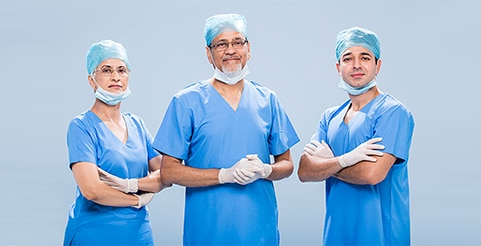Pulmonology
The department of respiratory medicine offers personalized treatment for the diseases afflicting lungs, chest and thoracic region. MGM Healthcare prioritizes treating conditions like tuberculosis (TB), pneumonia, asthma, sleep apnoea and more. The hospital aids patients to achieve their health goals right from prevention to self-management of these chronic diseases. Equipped with state-of-the-art biomedical advances the department carries out modern treatment modalities in an all-inclusive set-up.
- Round the clock services to support emergency situations concerning shortness of breath
- Comprehensive treatment and procedure for the Covid-19 affected lungs
- Access to a multidisciplinary integrated facility for transplantation programs
Our Chest Clinic
- Allergy, Asthma Clinic
- COPD Clinic
- Smoking Cessation Clinic
- Pulmonary rehabilitation Clinic
- Lung Cancer Detection Clinic
- TB Clinic
- Pulmo Check Clinic
- Sleep Clinic
- Respiratory Vaccine Clinic
Conditions we treat and procedures we do
Bronchoscopy is a commonly performed interventional procedure in pulmonology. We have paediatric and adult bronchoscopy instruments for the diagnosis and treatment of various pulmonology disorders like lung cancer, TB and interstitial lung disease etc.
Indication for bronchoscopy for haemoptysis and endobronchial disease evaluation and sampling like wash, Brush, biopsy, Trans bronchial needle aspiration (TBNA) and TransBronchial Lung Biopsy (TBLB)
Advanced bronchoscopy like endo bronchial ultrasound (EBUS) for the evaluation of mediastinal lymphadenopathy, central and peripheral lung lesions
Therapeutic bronchoscopy for the removal of mucus plug, blood clots, lavage, glue therapy in haemoptysis and broncho pleural fistula, Bronchial dilation using balloon and airway stenting.
Medical thoracoscopy or pleuroscopy is a minimally invasive procedure that allows access to the pleural space using a combination of viewing and working instruments. It also allows for basic diagnostic (undiagnosed pleural effusion and pleural thickening) and therapeutic procedures (pleurodesis and adhesiolysis) to be performed safely under local anaesthesia and conscious sedation.
Indications for Diagnostic Thoracoscopy
- Pleural effusion of unknown origin
- Suspected tuberculosis effusion
- Suspected malignancy with inconclusive cytology
- Recurrent pleural effusion
- Hemorrhagic pleural effusion
- Recurrent Pneumothorax
Indications for Therapeutic Thoracoscopy
- For pleurodesis in malignant, recurrent pleural effusion and recurrent pneumothorax
- To divide adhesions in recurrent / in persistent spontaneous pneumothorax and minimal loculated pleural effusion
- To perform pleural toilet in the fibrino purulent stage of empyema
Obstructive sleep apnoea (OSA) is a common respiratory disorder that comes under sleep disordered breathing. The following symptoms of sleep apnoea-snoring, choking or gasping during sleep, frequent sleep awakening, morning headache, fatigue, tiredness and excessive obstructive sleep apnoea are obese, short stature, hypothyroid, micrognathia and retrognathia.
The diagnosis of confirmation is polysomnography that is sleep study
- Treatment of obstructive sleep apnoea is multidisciplinary that may involve weight reduction, correction of upper positive airway pressure (CPAP), lifestyle modifications and more.
- Complications of obstructive sleep apnea are uncontrolled hypertension, fluctuating sugar level, uncontrolled asthma, heart attack, cerebrovascular accident, road traffic accident, cancer and depressive psychosis.
Pleural effusion treatment – pleurocentesis performed to remove the excess fluid build-up (space between your lungs and the wall of the chest). The physician might recommend for pleurocentesis When a they experience chronic cough, shortness of breath or chest pain. The treatment aids in the diagnosis, treatment of the lung and its function. Pleurocentesis can also be called thoracentesis. The treatment confirms or rules out diseases or infections like cancer, congestive heart failure, pneumonia or pulmonary hypertension.
How is it performed?
- After the patient evaluation (Chest X-ray), The physician performs an ultrasound to determine and find the apt location to place the needle that removes excess fluid and extracts the sample.
- The patient may be administered with a local anaesthetic to minimize the discomfort.
- After anaesthetic administration, with the help of ultrasound, your doctor carefully guides the needle through ribs and inside the chest.
- The needle removes the excess fluid present in the space. The doctor collects a fluid sample and tissue sample for further analysis and biopsy.
- A small bandage is placed to cover the place where the needle was inserted. A Chest X-ray may be recommended to examine the aftermath of the procedure.
A spirometry test measures a patient’s ability to inhale and exhale air through the lungs. Spirometry evaluation examines the ease and flow of air blown out from the lungs. Pulmonologists recommend spirometry tests if the patients suffer from cough, shortness of breath, wheezing.
The effectiveness of medicines administered to the patient can be checked in chronic respiratory conditions like Asthma, pulmonary fibrosis and COPD through spirometer.
Tube thoracotomy- A minimally invasive procedure where a thin plastic tube is inserted into the pleural space to remove excess space, fluid & other particles. With the support of ultrasound, fluoroscopy or computed tomography,
a thin tube is places into the chest allowing the lungs to function effectively. Apart from removing the excess fluid, tube thoracotomy aids to delivering medication into the pleural space.
How tube thoracotomy is performed?
- The doctor elevates the head of the patients’ bed by 30 – 60 degree and identifies the tube insertion site.
- Usually, the tube thoracotomy is performed under general anaesthesia to numb the site. Following anaesthesia, the doctor checks for the right area by inserting the needle deeply and makes an incision about 2 – 3 cm
- Using a surgical instrument named Kelly clamp, the area is widened slowly to gain the access of pleural space allowing the doctor to check for scar or mass tissue
- Through the incision site, the doctor inserts the chest tube. Draining of excess fluid through the tube confirms the proper insertion of the chest tube, if not the tube might be subjected to repositioning.
- Tubes are sutures at place allowing the seal to be airtight as possible. The incision site is then covered with the gauze pads. Once the procedure is completed, the patient is examined for chest X- ray to confirm the tube placement.


 In-person Consultation
In-person Consultation Online Video Consultation
Online Video Consultation Treatment Enquiries
Treatment Enquiries Find a Doctor
Find a Doctor Access the Patient Portal
Access the Patient Portal +91 44 4524 2407
+91 44 4524 2407  Minimal Access GI & Bariatric Surgery
Minimal Access GI & Bariatric Surgery Multi-Visceral and Abdominal Organ Transplant
Multi-Visceral and Abdominal Organ Transplant Neurology
Neurology Spine Surgery
Spine Surgery Total Knee replacement
Total Knee replacement Anaesthesiology & SICU
Anaesthesiology & SICU Paediatric Cardiology
Paediatric Cardiology Emergency Na MGM
Emergency Na MGM IVF
IVF Oncology Treatments
Oncology Treatments







